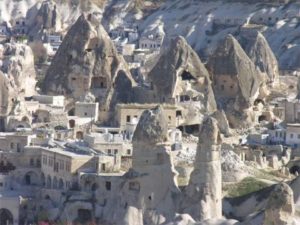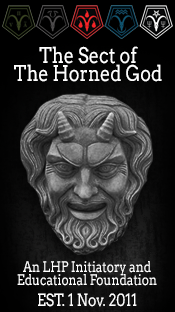In the Beginning
By Ryan of the North, Member of The Sect of the Horned God
A very surprising archeological find in Turkey has cause a shake up of humanity’s evolutionary timeline from mindless beast functioning on pure instinct to the mess of civilization we have today. Known as Göbekli Tepe (Turkish for pot bellied hill), the site is home to multiple circles of very large expertly carved limestone pillars said to be about 7,000 years older than the pyramids of Giza; dating back some 11,500 years to the era of the late Paleolithic age. The roots of human spirituality, and the Left Hand Path, may be hidden in the story of these mysterious monoliths.
In 1963, the University of Chicago and the University of Istanbul conducted a survey during which the site was mistaken for a Byzantine era cemetery. Peter Benedict, an American archeologist having only seen the surface findings concluded the lithic where of Neolithic origins and mistook the large T shaped pillars for gravestones. In 1994 however, a German archeologist took interest in the hillside after reading the area findings from 1963. This man, Klaus Schmidt, has so far seen only 5% of the total area excavated as there was more under the hill than previously assumed. Turns out, the 16-ton monoliths are but one of many temples built one on top of the other. The people who made this temple also made the hillside it was seated upon. The people buried the original temples to makes newer smaller temples in the same location every few decades. How many times had this society excavated, artistically carved and transported the limestone used in these first temples? A magnetic survey in 2003 reveals 20 circular temples are buried at Göbekli Tepe all with similar design in decrementing size.
In the June 2011 issue of National Geographic Magazine, Charles C. Mann documents the way this site has changed perspectives since its discovery. His article entitled The Birth of Religion states that these massive stones had been transported hundreds of feet by people who had no wheel or beast of burden to ease the work. This would require hundreds of workers to extract, carve and move such stones. Yet, Göbekli Tepe has no evidence of agriculture, no huts, no immediately available water source as the closest stream is 3 miles away. This temple was not apart of a settlement of farmers and herdsmen; it was only used as a place of divine reverence by hunter-gatherers. The limestone pillars have been decorated in low relief etched images and high relief carved out images of animals such as snakes/serpents, lions, scorpions, bulls and birds similar to totems. Evidence has also surfaced as to the practice of personal ancestor reverence. Some prehistoric burial sites are missing skulls and show evidence of reburial. Was this the start of shamanism and funerary beliefs for human kind in a community format?
Let us consider these points. Foragers and hunters became religious before they became civilized. Did religion birth civilization? While no settlement is to be found at Göbekli Tepe, there have been small hunter-gatherer settlements near to the hillside. Wheat would eventual evolve a stronger bond between plant and seed. This evolutionary development would mean very little to a wild plant. But for the wandering humans, it was perfect for harvesting, storing and eventually planting wheat where ever they could sew the seeds. The advent of farming would kill the religion of the foraging homo sapiens and birth new religions for the new ways.
The hill top temple became less attractive to the people who inherited the farm as opposed to those who inherited a fully wild world. Once farming became the norm temples where built closer to the settlements and not set on a cycle of build, bury and rebuild. Once, multiple settlements consisting of a couple dozen individuals each used one temple for an entire area. Now, the gods came down from the hills. And wilds to the human settlements.
The following is one hundred percent conjecture for the purpose of speculation and contemplation. A split in mentality happened. Those who saw the gods as being one with humanity and those who saw them separate from humanity. Those who wished to continue the old ways, and those who saw the value of change. Why should we have to plough the field, sew the seeds, tend the garden and animals, then bury and rebuilt temples on top of all that. Where the first blazers of the Left Hand Path the people who wanted a more personalized connection with the gods? No real way to know, but one thing you can be sure of, spirituality is an evolutionary part of being human.






